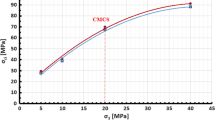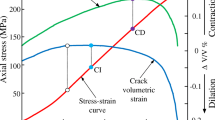Abstract
Depending on the type of failure mechanism, the strength of intact rock may be susceptible to the effects of scale. The influence of scale is apparent in the spalling of rock around underground openings. To reconcile field-scale observations, an understanding of the unconfined rock strength has to be appreciated from the standpoint of energy instability, particularly for instances in which the mechanism of failure involves propagation of fractures. Fracture energy principles were used to create a link between laboratory-measured uniaxial compressive strength (UCS) and rock failure as observed in spalling around circular openings. An Instability Line (IL) is proposed to predict the stresses above which spalling could occur with different opening diameters. Good comparisons were obtained for a range of dimensions from small boreholes to large tunnels. Based on field observations and analytical study, the results suggest that two conditions are required for spalling to occur. The first is that the crack initiation stress has to be exceeded, and the second is that the stress needs to be above the IL. The findings suggest that the effects of scale are limited by the crack initiation stress. For large-diameter openings, instability occurs immediately at crack initiation stress, whereas for smaller-diameter openings instability occurs at higher stresses post-crack initiation stress.
Highlights
-
This paper aims to explain the discrepancies in the rock mechanics literature to predict spalling for small-diameter boreholes as against large-diameter tunnels.
-
The failure mechanism of spalling is studied based on the framework of energy stability. An Instability Line is proposed based on the analytical study.
-
The results of the analytical study compared well with published laboratory and field observations.
-
The results suggest that two conditions are required for spalling to occur. The first is that the crack initiation stress has to be exceeded, and the second is that the stress needs to be above the Instability Line.
-
The findings suggest that the effects of scale are limited by the crack initiation stress.








Similar content being viewed by others
Abbreviations
- σ ci :
-
Crack initiation stress
- σ cd :
-
Crack damage stress
- σ max :
-
Maximum stress
- σ θθ :
-
Tangential stress at borehole wall
- σ il :
-
Stress threshold for instability
- τ :
-
Shear stress
- τ oct :
-
Octahedral shear stress
- ϕ :
-
Friction angle
- γ :
-
Specific surface energy
- v :
-
Poisson’s ratio
- db:
-
Half-length of microcracks
- c :
-
Half-crack length
- D :
-
Scale
- db:
-
Half-length of microcrack
- h :
-
Efficiency parameter
- k :
-
Factor to maximum stress for driving stress
- R :
-
Radius of circular opening
- UCS:
-
Uniaxial compressive strength
- E :
-
Young’s modulus
- G :
-
Shear modulus
- IL:
-
Instability Line
- J 2 :
-
Second deviatoric stress invariant
- \(\Delta P\) :
-
Energy release
- U :
-
Energy stored around a crack
- W :
-
Energy demand or absorbed
- W D :
-
Limiting distortional energy
References
Barton N (2013) Shear strength criteria for rock, rock joints, rockfill and rock masses: problems and some solutions. J Rock Mech Geotech Eng 5(4):249–261
Barton N, Pandey S (2011) Numerical modelling of two stoping methods in two Indian mines using degradation of c and mobilization of ϕ based on Q parameters. Int J Rock Mech Min Sci 48(7):1095–1112
Barton N, Shen B (2018) Extension strain and rock strength limits for deep tunnels, cliffs, mountain walls and the highest mountains. Rock Mech Rock Eng 51:3945–3962
Bažant Z, Lin FB, Lippmann H (1993) Fracture energy release and size effect in borehole breakout. Int J Numer Anal Methods Geomech 17:1–14
Boon CW (2019) Study of reinforcement support mechanisms for wide-span horse-shoe-shaped openings in horizontally layered jointed rock using the distinct element method. Rock Mech Rock Eng 52:1179–1191
Cai M, Kaiser PK (2014) In-situ rock spalling strength near excavation boundaries. Rock Mech Rock Eng 47(2):659–675
Cai M, Kaiser PK, Tasaka Y, Maejima T, Morioka H, Minami M (2004) Generalized crack initiation and damage stress thresholds of brittle rock masses near underground excavations. Int J Rock Mech Min Sci 41:833–847
Carter BJ (1992) Size and stress gradients effects on fracture around cavities. Rock Mech Rock Eng 25(3):167–186
Cook NGW (1965) The failure of rock. Int J Rock Mech Min Sci 2:389–403
Diederichs MS (2003) Rock fracture and collapse under low confinement conditions, vol. 36(5). Rock Mech Rock Eng 36:339–381
Diederichs MS (2007) The 2003 Canadian geotechnical colloquium: mechanistic interpretation and practical application of damage and spalling prediction criteria for deep tunnelling. Can Geotech J 44:1082–1116
Eberhardt E, Stead D, Stimpson B, Read RS (1998) Identifying crack initiation and propagation thresholds in brittle rock. Can Geotech J 35:222–223
Einstein HH, Baecher GB, Hirschfeld RC (1970) The effect of size on strength of brittle rock. Proc ISRM 2(3–2):7–13
Fakhimi A, Hemami B (2017) Rock uniaxial compression test and axial splitting. Proc Eng 191:623–630
Glucklich J, Cohen L (1967) Size as a factor in the brittle-ductile transition and the strength of some materials. Int J Fract Mech 3:278–289
Griffith AA (1921) The phenomena of rupture and flow in solids. Phil Trans R Soc Series A 221:163–198
Hajiabdolmajid V, Kaiser P, Martin CD (2003) Mobilised strength components in brittle rock. Geotechnique 53(3):327–336
Hencky HZ (1924) Zur Theorie Plasticher Deformationen und der Hierdurch im Material Hervorgerufenen Nachspannungen. Z Angerw Math Mech 4:323–334
Hoek E, Brown ET (1980) Underground excavations in rock. The Institution of Mining and Metallurgy, London, p 527
Hoek E, Brown ET (2019) The Hoek–Brown failure criterion and GSI-2018 edition. J Rock Mech Geotech Eng 11(3):445–463
Hoek E, Martin CD (2014) Fracture initiation and propagation in intact rock – A review. Rock Mech Rock Eng 6(4):287–300.
Lajtai EZ (1972) Effect of tensile stress gradient on brittle fracture initiation. Int J Rock Mech Min Sci 9:569–578
Lee M, Haimson B (1993) Laboratory study of borehole breakouts in Lac du bonnet granite: a case of extensile failure mechanism. Int J Rock Mech Min Sci Geomech Abst 30(7):1039–1045
Lee H, Jeon S (2011) An experimental and numerical study of fracture coalescence in pre-cracks specimens under uniaxial compression. Int J Solids Struct 48(6):979–999
Lee H, Moon T, Haimson BC (2016) Borehole breakouts induced in Arkosic sandstones and a discrete element analysis. Rock Mech Rock Eng 49:1369–1386
Lin H, Oh J, Canbulat I, Stacey TR (2020) Experimental and analytical investigations of the effect of hole size and borehole breakout geometries for estimation of in situ stress. Rock Mech Rock Eng 53:781–798
Martin CD (1997) Seventeenth Canadian geotechnical colloquium: the effect of cohesion loss and stress path on brittle rock strength. Can Geotech J 34:698–725
Martin CD, Chandler NA (1994) The progressive fracture of Lac du Bonnet granite. Int J Rock Mech Min Sci 31(6):643–659
Martin CD, Kaiser PK, McCreath DR (1999) Hoek-Brown parameters for predicting the depth of brittle failure around tunnels. Can Geotech J 36:136–151
Nicksiar M, Martin CD (2013) Crack initiation stress in low porosity crystalline and sedimentary rocks. Eng Geol 154:64–76
Pelli F, Kaiser PK, Morgenstern NR (1991) An interpretation of ground movements recorded during construction of the Donkin-Morien tunnel. Can Geotech J 28(2):239–254
Perras MA, Diederichs MS, Besaw D (2014) Geological and geotechnical observations from the Niagara Tunnel Project. Bull Eng Geol Environ 73:1303–1323
Shen B, Barton N (2018) Rock fracturing mechanisms around underground openings. Geomech Eng 16(1):35–47
Stacey TR (1981) A simple extension strain criterion for fracture of brittle rock. Int J Rock Mech Min Sci Geomech Abstr 18:469–474
Tang AT, Hudson JA (2010) Rock failure mechanisms: explained and illustrated. CRC Press, Taylor & Francis Group, London, p 322
Vásárhelyi B, Bobet A (2000) Modeling of crack initiation, propagation and coalescence in uniaxial compression. Rock Mech Rock Eng 33(2):119–139
Barton N (2010) Low stress and high stress phenomena in basalt flows. In: Keynote paper. 3rd international workshop on rock mechanics and geo-engineering in volcanic environments. Tenerife.
Cosgrove JW, Hudson, JA (2016) Structural geology and rock engineering. Imperial College Press, p. 534.
Fairhurst C (2004) Fundamental considerations relating to the strength of rock. In: Report on the workshop on extreme ground motions at yucca mountain, US Geological Survey, Menlo Park, California, August 23–24, 2004.
Haimson BC, Herrick CG (1989) Borehole breakouts and in situ stress. In Proc. 12th Annual Energy-Sources Technology Cof. & Exhibition, Drilling Symp., pp. 17–22. American Society Mechanical Engineers, New York.
Jiayou L, Lihui D, Chengjie Z, Zebin W (1989) The failure of rock around underground openings. In: Maury V, Fourmaintraux D. Balkema AA (eds) Proceedings of the Conference on Rock Mechanics and Rock Physics at Great Depth, Pau, France, vol. 2, Rotterdam, pp. 567–574.
Kaiser PK, Diederichs MS, Martin CD, Sharp J, Steiner W (2000) Underground works in hard rock tunnelling and mining, GeoEng 2000, Technomic Publ. Co., pp. 841–926
Kirsten HAD, Klowkow JW (1979) Control of fracturing in mine rock passes. In: Proceedings of the 4th ISRM Congress on Rock Mechanics, Montreux. Vol. 1. A.A. Balkema, Rotterdam, pp. 203–210.
Lan H, Martin CD, Andersson JC (2013) Evolution of in situ rock mass damage induced by mechanical-thermal loading. Rock Mech Rock Eng: 446–153–168.
Martin CD (1989) Failure observations and in situ stress domains at the underground research laboratory. In: Maury V, Fourmaintraux D (eds) Proceedings of the Conference on Rock Mechanics and Rock Physics at Great Depth, Pau, France, pp. 719–726
Martin CD (1993) Strength of massive Lac du Bonnet granite around underground openings. PhD thesis, Department of Civil & Geological Engineering, University of Manitoba, Winnipeg, Manitoba, Canada.
Martin CD, Martino JB, Dzik EJ (1994) Comparison of borehole breakouts from laboratory and field tests. In: SPE 28050, SPE/ISRM Rock Mechanics in Petroleum Engineering Conference. Society of Petroleum Engineers. Delft, the Netherlands, 29–31 August 1994, 183–190.
Mastin L (1984) The development of borehole breakouts in sandstone. Master’s thesis, Standford University, Berkeley
Mogi K (2006) Experimental rock mechanics. Taylor & Francis, p. 361.
Ortlepp WD, Gay NC (1984) Performance of an experimental tunnel subjected to stresses ranging from 50 MPa to 230 MPa. In: Brown ET, Hudson J (eds) Proceedings of the ISRM symposium: design and performance of underground excavations. British Geotechnical Society, London, pp 337–346
Stacey TR, de Jongh CL (1997) Stress fracturing around a deep-level bored tunnel. J South Afr Inst Min Metall: 124–133.
Zoback MD (2010) Reservoir Geomechanics. Cambridge University Press, p. 449.
Acknowledgements
The views in this paper are those of the author and not the affiliated organization. Discussions with the late Professor John Hudson in 2013 on his views of a rock failure criterion are acknowledged.
Author information
Authors and Affiliations
Corresponding author
Additional information
Publisher's Note
Springer Nature remains neutral with regard to jurisdictional claims in published maps and institutional affiliations.
Rights and permissions
About this article
Cite this article
Boon, C.W. An Instability Line for Spalling Around Circular Openings and the Limiting Effects of Scale. Rock Mech Rock Eng 55, 5759–5772 (2022). https://doi.org/10.1007/s00603-022-02943-3
Received:
Accepted:
Published:
Issue Date:
DOI: https://doi.org/10.1007/s00603-022-02943-3




